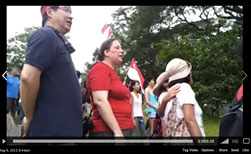
August 9th is National Day in Singapore, and it is accompanied by both public and private celebrations. From my family’s flat in the public housing estate of Hougang, we can hear the roar of jet planes over our heads as they make their way to the National Day Parade grounds for a fly-past and appear shortly before our eyes on the television screen. Over the years, National Day has become a festive affair for an extended family gathering that includes cousins, nieces and aunties, and an excuse to cook-up a feast - a hearty steamboat or hotpot dinner (see picture inset) usually reserved for the Chinese New Year.
Dinner is punctuated with reminiscences as well as animated conversations with my primary-school-going niece about the National Day revelry at her school, and we all wait in anticipation to catch the venerable former Prime Minister Mr. Lee Kuan Yew make his appearance amongst the VIP spectators. We take note of his state of health and the uniformity o f outfits worn by the entourage of the ruling People’s Action Party (PAP) Ministers and Members of Parliament. When the national anthem is being sung, I watch from the corner of my eyes at my father silently mouthing the words to “Majulah Singapura” and become acutely conscious of our affinity or bonds not just as family but also as Singaporeans.
 Yet proud of what we have built, many Singaporeans are also concerned with what we may be losing. On the same day of August 9th elsewhere in this island-state of Singapore, a tireless group of activists1 are conducting an evening tour of the old Bukit Brown cemetery in an effort to raise awareness of the “forgotten histories” of those pioneers – coolies, poets, philanthropists, businessmen, bankers, educationists, doctors, diplomats, musicians, builders, architects and war heroes who now lay there but whose stories and contributions to society have not (yet) been told. Their tombs were to be exhumed and the cemetery leveled for the construction of a 6-lane expressway. Working with urgency and energetic vigor, the activists advocate for the preservation of Bukit Brown cemetery as a “living heritage site”. Put together with other groups such as Nature Society, Transient Workers Count Too (TWC2), Association for Women’s Action and Research (AWARE) etc., the Bukit Brown activists form part of an emerging social and cultural movement in Singapore that reflects the changing character and ethos of its society.
Yet proud of what we have built, many Singaporeans are also concerned with what we may be losing. On the same day of August 9th elsewhere in this island-state of Singapore, a tireless group of activists1 are conducting an evening tour of the old Bukit Brown cemetery in an effort to raise awareness of the “forgotten histories” of those pioneers – coolies, poets, philanthropists, businessmen, bankers, educationists, doctors, diplomats, musicians, builders, architects and war heroes who now lay there but whose stories and contributions to society have not (yet) been told. Their tombs were to be exhumed and the cemetery leveled for the construction of a 6-lane expressway. Working with urgency and energetic vigor, the activists advocate for the preservation of Bukit Brown cemetery as a “living heritage site”. Put together with other groups such as Nature Society, Transient Workers Count Too (TWC2), Association for Women’s Action and Research (AWARE) etc., the Bukit Brown activists form part of an emerging social and cultural movement in Singapore that reflects the changing character and ethos of its society.
 The sense of loss is one of the themes that “Cook a Pot of Curry” - a witty, humorous and poignant theatrical production by local playwright Alfian Sa’at, tackles with great nuance. Staged by theatre group “Wild Rice” in July, 2013, it was sold-out on almost every performance night. The play reflects critically on what it means to be Singaporean. It confronts the recent influx of immigrants, foreign talents and workers that has given rise to a tide of anti-foreigner sentiments blamed for everything from “overcrowding on public transport, escalating property prices and wage depression” (Wild Rice: Alfian in the spot-light). Using a high-profile dispute between a recently arrived immigrant couple from China who had complained to the authorities about their Singaporean Indian neighbors because they could not stand the smell of curry being cooked next door, the play draws attention to the ridiculous “solution” proffered by the mediating authority to the Indian family to cook curry only at stipulated times. This ruling threw Singaporean society into a frenzied fit of private curry parties as a protest against the government, fuelled the toxic seething anti-foreigner sentiments and inspired a popular Singaporean blogger Mr. Brown to spoof the song “Curry Curry Night”, karaoke style. The play itself grapples with issues of population, immigration and identity that converge on the question of home. But "Is this home?", asks a character in the play as he sings wistfully to a Youtube parodied national day song.
The sense of loss is one of the themes that “Cook a Pot of Curry” - a witty, humorous and poignant theatrical production by local playwright Alfian Sa’at, tackles with great nuance. Staged by theatre group “Wild Rice” in July, 2013, it was sold-out on almost every performance night. The play reflects critically on what it means to be Singaporean. It confronts the recent influx of immigrants, foreign talents and workers that has given rise to a tide of anti-foreigner sentiments blamed for everything from “overcrowding on public transport, escalating property prices and wage depression” (Wild Rice: Alfian in the spot-light). Using a high-profile dispute between a recently arrived immigrant couple from China who had complained to the authorities about their Singaporean Indian neighbors because they could not stand the smell of curry being cooked next door, the play draws attention to the ridiculous “solution” proffered by the mediating authority to the Indian family to cook curry only at stipulated times. This ruling threw Singaporean society into a frenzied fit of private curry parties as a protest against the government, fuelled the toxic seething anti-foreigner sentiments and inspired a popular Singaporean blogger Mr. Brown to spoof the song “Curry Curry Night”, karaoke style. The play itself grapples with issues of population, immigration and identity that converge on the question of home. But "Is this home?", asks a character in the play as he sings wistfully to a Youtube parodied national day song.
 In spite of the tension between locals and foreigners, the play manages to convey their shared sense of marginalization and loss, confusion and anxiety. Through testimonies gathered from a series of interviews with people from all walks of life in Singapore, “Cook a Pot of Curry” showcases these individual voices that include excerpts from “Remalyn”, a 30-year-old Filipina domestic helper; “Ravi”, a 40-year-old Singaporean social worker; “Evelyn”, a 28-year-old Singaporean Yoga instructor; “Xiaoqing”, a 23-year-old post-graduate student from China, and “Syamsul”, a 33-year-old Singaporean civil servant into the script. These voices represent the diversity of views that range from “new citizens who support the ruling party, foreigners who don’t really like Singapore, citizens who hate foreigners”, says Nelson Chia who plays the role of the post-graduate student from China as well as a Singaporean labor activist (See “Art imitates Life” 15-July-2013: Interview with Nelson Chia).
In spite of the tension between locals and foreigners, the play manages to convey their shared sense of marginalization and loss, confusion and anxiety. Through testimonies gathered from a series of interviews with people from all walks of life in Singapore, “Cook a Pot of Curry” showcases these individual voices that include excerpts from “Remalyn”, a 30-year-old Filipina domestic helper; “Ravi”, a 40-year-old Singaporean social worker; “Evelyn”, a 28-year-old Singaporean Yoga instructor; “Xiaoqing”, a 23-year-old post-graduate student from China, and “Syamsul”, a 33-year-old Singaporean civil servant into the script. These voices represent the diversity of views that range from “new citizens who support the ruling party, foreigners who don’t really like Singapore, citizens who hate foreigners”, says Nelson Chia who plays the role of the post-graduate student from China as well as a Singaporean labor activist (See “Art imitates Life” 15-July-2013: Interview with Nelson Chia).
The play is not afraid to confront “sensitive issues of race and nationality” – issues rendered taboo by the government of former Prime Minister Mr. Lee Kuan Yew, which sought to defuse the country’s turbulent race relations and religious tensions in the past. The PAP-government’s tight grip on those “out-of-bound” markers have for a long period of time defined for Singaporeans their identity and its meanings that are affixed in a specific time, space and purpose. But these are being unloosened by groups like the Bukit Brown activists who work tirelessly – tombstone by tombstone – to unravel nuggets of stories and memories that may one day present an alternative narrative of, and a trajectory for Singapore.
Although maybe not as quickly as some might hope, things are changing gradually: in the National Day message of 2013, the Prime Minister of Singapore Mr. Lee Hsien Loong centered his 10-minute speech on the notion of “home”. Speaking from a National Servicemen clubhouse in the public housing estate of Toa Payoh, Mr. Lee took stock of the progress made during the past year: more public housing and stabilized prices in the red-hot housing market; more buses, bus routes and new MRT train lines. Addressing national issues such as the population, economy and the changing global conditions, he spoke to ordinary Singaporeans about our concerns: crowding and congestion, job security, cost of living, the Singaporean identity and whether our children will do better than ourselves.
However, the work of making a home out of Singapore goes beyond building brick-and-mortar houses. In its own way, “Cook a Pot of Curry” attests to the complexity of making a home out of Singapore: it presents the diversity of views and complicated emotions that do not suggest any clear-cut or straightforward “solution” towards resolving the tensions and conundrums which have arisen, and engenders questions not easily nor readily answered as Nelson Chia puts it:
“It is quite poignant for me. I am a Singaporean but I have relatives that are Permanent Residents (PR) and friends who are foreigners. Rationally, I can understand the policies… but complexities come because a lot of us are not prepared for the changes. For example, rationally, you know if you lose a job to a foreigner, it is not their fault. But somehow, people take it personally…This play raises a number of questions for me as well.” (“Art imitates Life” 15-July-2013: Interview with Nelson Chia).
“Joanne” – a dour-faced teacher from the play who derides the effort to create a national costume for Miss Singapore Universe showcasing “Singaporean-ness” in all its farcical superficiality, reflects the futility of such socio-cultural projects. Likewise, we may rationalize how social, political and cultural forces have come to shape the meanings of “home” but through “Cook a Pot of Curry”, we realize that it is our longing for inclusiveness, recognition, acceptance and affinity which makes home a possibility. However, when people like Alfian Sa’at continues to be derided and his discourse policed by Singapore’s mainstream media, it is no wonder that many of us – locals and foreigners alike, struggle to call Singapore – home.
Arthur Chia is a Singaporean Post-doctoral Fellow in the Singapore University of Technology and Design (SUTD) - MIT joint program. He is a student of Southeast Asian studies; anthropology and Science, Technology and Society (STS) studies.
1 Inset picture shows activists and participants singing “Majulah Singapura” at Bukit Brown on National Day August 9th 2013: Bukit Brownies singing "Majulah Singapura".
- Login to post comments
 Email this Story
Email this Story













I recently came across your
I recently came across your blog and have been reading along. I thought I would leave my first comment. I don’t know what to say except that I have enjoyed reading. Nice blog, I will keep visiting this blog very often.
Edward Bass New York
I found your this post while
I found your this post while searching for some related information on blog search...Its a good post..keep posting and update the information.
text an ex back
Positive site, where did u
Positive site, where did u come up with the information on this posting? I'm pleased I discovered it though, ill be checking back soon to find out what additional posts you include.
best way to make a girl your girlfriend
This is a great post. I like
This is a great post. I like this topic.This site has lots of advantage.I found many interesting things from this site. It helps me in many ways.Thanks for posting this again.
https://rebelmouse.com/rebuildhairprogramreviews/
This is very educational
This is very educational content and written well for a change. It's nice to see that some people still understand how to write a quality post!
cómo comprar el pdf
This is very nice post
Thanks for it, i have been seeking for information regarding this material for ages and yours is that the best I even have discovered up to now.
pressure steam sterilizers autoclave
This is very nice post
I want to it articles thank for your time of this nice read!!! I definitely enjoy every little bit of it and I have you bookmarked to check out new stuff on your blog a must read blog!!!!
Digital Microscope ,binocular Microscope with camera attachments
Interesting and amazing how
Interesting and amazing how your post is! It Is Useful and helpful for me That I like it very much, and I am looking forward to Hearing from your next..
rijschoolmerelbeke.be
I am hoping the same best
I am hoping the same best effort from you in the future as well. In fact your creative writing skills has inspired me.
girlfriendactivationsystemreviews